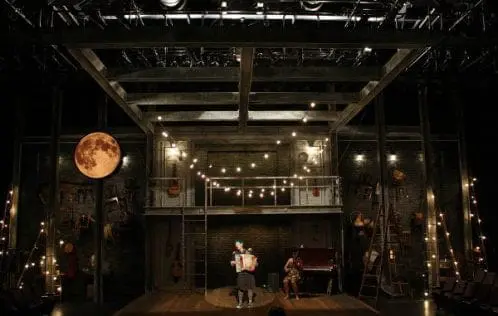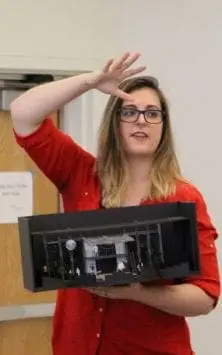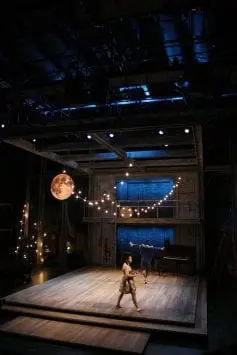“Whimsical stuff and things”: A Scenic Designer Sets the Stage
“Paige Hathaway’s scenic design evokes a weathered downtown warehouse with stark steel ladders and a sumptuous moon hanging high over the various found objects in the background. At times the space seems to glow from every corner with the magical fairy ambiance created by lighting designer Thom Weaver.” DC Metro Arts

Photo: Paige Hathaway
Paige Hathaway answers questions about her artistic process as a scenic designer and the magic behind the whimsical and modern set of “A Midsummer Night’s Dream.”
 What first interested you about theatrical design?
What first interested you about theatrical design?
Theatrical design felt like a natural combination of my love of fine art and theatrical storytelling. When I design sets, I’m able to create worlds and environments while collaborating with artists who inspire me to tell a story. For me, there’s nothing more fulfilling.
When you read a play for a job, what information are you searching for to start designing?
When I read a play for the first time, I try to take it in like an audience member would. I like to lose myself in the story and the characters and take note of how the effect me. My second time reading the play, I’ll look for specific staging needs, pieces of furniture, time of day, etc. I also like to pull out pieces of dialogue or stage directions that hint at the emotional landscape of the play or any overarching themes. This will ultimately be the foundation on which I build my design.
 What was the vision for A MIDSUMMER NIGHT’S DREAM set?
What was the vision for A MIDSUMMER NIGHT’S DREAM set?
Matt Pfeiffer (the director) and I set out to create a neutral, ritualistic theatrical space that contains nods or hints towards the themes and set pieces of Midsummer without being beholden to them. For example, we didn’t feel the need to have actual trees or foliage onstage, the language of Shakespeare alone paints the picture for the audience. Instead, we hint at trees and forest through the ladders on either side of the stage and through Thom Weaver’s amazing lighting design. We wanted tastes of magic and whimsy, while still being firmly in a theatrical space.
Do you have a unique style that runs through all of your scenic design projects?
My friends and I joke that my style can be described as “whimsical stuff and things.” However, I do try to not get stuck in doing any particular style. That being said, a handful of my designs have some common aesthetics. I often find myself trying to incorporate lighting fixtures and elements into my designs as much as possible; from table lamps and strings of lights, to moon light boxes and light-up jam jars. I enjoy incorporating light into my designs, which makes my collaboration with the lighting designer all the more important.
How do you collaborate with the director, costume designer, lights and sound to create one cohesive production?
The structure of my collaboration often fluctuates from project to project. On some projects, my conversations about the design for the show begin with just the director and no other designers. On others, the entire creative team has conversations together (which I prefer). Regardless, most of the time a director will have a clear vision or path down which they would like to take the production. From there, the designers and I will discuss, interrogate, and riff off of these ideas until we find a cohesive whole with everyone playing their part. This is my favorite part of the process and why I enjoy designing for theater.
Describe for your process from design conception to opening night.
My first step when I am designing a show is to, of  course, read the script. I read it a couple of times, thinking about the location, time period, emotional landscape, and practical needs. After reading the play, I begin conversations with the director and creative team. We start to dream up the world of the play and how express that world visually. I usually do some visual research after an initial concept meeting. I gather images that inspire me or provide contextual information for era or location.
course, read the script. I read it a couple of times, thinking about the location, time period, emotional landscape, and practical needs. After reading the play, I begin conversations with the director and creative team. We start to dream up the world of the play and how express that world visually. I usually do some visual research after an initial concept meeting. I gather images that inspire me or provide contextual information for era or location.
After the team responds to the research, I usually have enough information to take my first stab at actually designing the set. I create a rendering of the set, typically using Photoshop. I try to render the set to look as realistic as possible so that the creative team can respond to the realities of the set. Depending on the responses of the team, I may revise the renderings or move forward to create a model.
When I’m modeling the design, I end up answering a lot of logistical questions about my design. How tall are the walls, what is the exact position of the deck, how many steps do I need to get to the second level, etc. If I do my job correctly, the model will be a perfect scale representation of what will end up on stage. In tandem with creating the model, I begin drafting the design. I create a groundplan, centerline section, and elevations of every pieces and part of the design. I use a computer-aided drafting program called Vectorworks to do all of this.
Once the final model is approved by the creative team, I send the drafting off to the Technical Director who will analyze my drafting, piece by piece, to create construction drawings for the set. Although I have a cursory knowledge of how to build scenery and the laws of physics, I am nowhere near as knowledgeable as a Technical Director. I rely completely on TDs to make my designs a reality.
After that, I am in touch with the Technical Director as he and his team start to build and paint the set. I’ll also be in conversations with the Prop Designer who will find and create the furniture, dressing, and hand props that are required for the design. This is when the design really starts to become a reality.
After the cast, director, and stage manager have been in rehearsals for a couple of weeks, we move into the final phase of the design and production. We have technical rehearsals where we start to put all of the pieces together. The actors are on the set for the first time, we add costumes, lights, and sound and begin to work through every cue in the show. It can be slow going, but is where the show as a whole truly takes shape. We will adjust or do notes on the set or props as needed to put a final polish on the design.
At last, we add the audience. You would be surprised by how much it changes the show. During preview performances, we listen to the audience’s responses and reactions and adjust if we feel we need to. It’s a vital part of the process. And then, we open!

Photo: Paige Hathaway
What element of this set are you most proud of?
I’m particularly fond of the two light box moons. They look just lovely, and the moment that they rise and glow is wonderful.
What was a challenge for this set?
The most challenging thing about the design was to find the balance between the messy, chaotic “backstage” world of the set and the clean, ritualistic stage-within-a-stage. It took some time during the rendering phase to find the right balance, and we continued to tweak through technical rehearsals. Ultimately, I feel that we found a great balance that is visually interesting.
Is there a play you have not done yet that you would love to design?
This is a hard question, because there are so many different types of shows that I would love to tackle. For a musical, I would love to do “Great Comet of 1812”… for a play, I would love to do a “Macbeth” or “Peter and the Star-catcher”… But more than anything, I get excited about working with people who push me creatively and make me look at a play in a new and inspiring way.
If you could give one piece of advice to young aspiring scenic designers, what would you say?
Reach out to the scenic designers in your area and ask them questions! More often than not, they would love to talk with you and help you find your way into this strange career. Work hard, don’t burn out, and find ways to fill your creative cup!
PAIGE HATHAWAY (Set Designer) Arden Debut! Regional: The How and the Why, Another Way Home, (Theater J); Ella Enchanted (Adventure Theatre MTC); Little Thing, Big Thing; Wild Sky (Solas Nua); The Gulf (Signature Theatre); The Pillowman (Forum Theatre); A Midsummer Night’s Dream, Rosencrantz and Guildenstern are Dead (Folger Theatre); Godspell (Olney
Theatre Center). Upcoming: A Chorus Line (The Muny); Or, (Round House Theatre); Thurgood (Olney Theatre Center). Training: University of Oklahoma, B.F.A. in Scenic Design, University of Maryland, M.F.A. in Scenic Design. www.paigehathawaydesign.com.
Buy tickets to A MIDSUMMER NIGHT’S DREAM by William Shakespeare, Music by Alex Bechtel, extended by popular demand thru April 13. For the Box Office, call 215.922.1122.

Photo of the cast by Ashley LaBonde.
